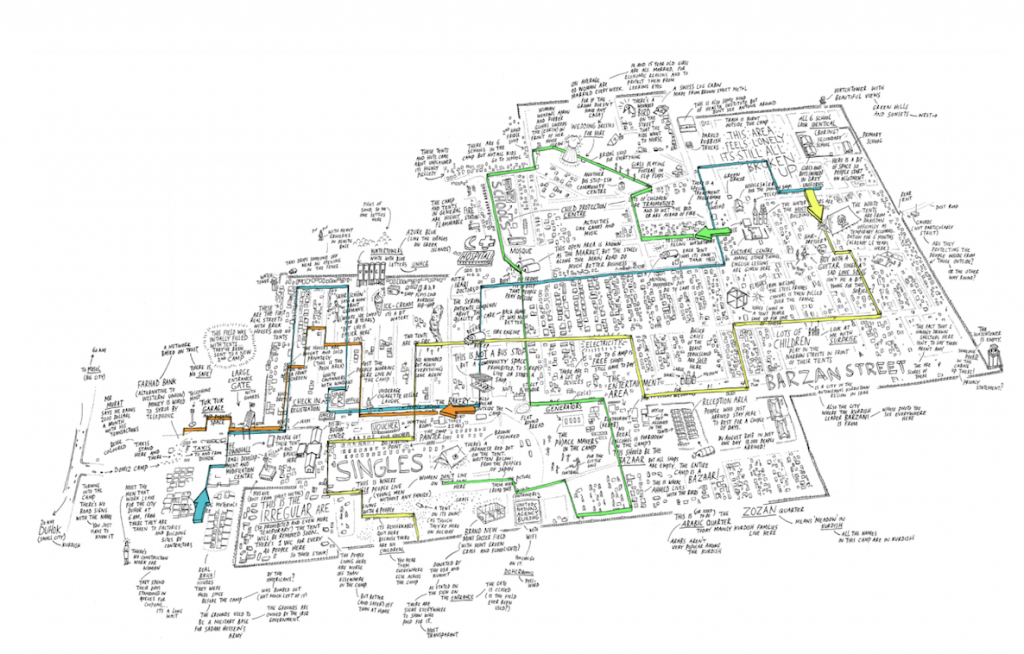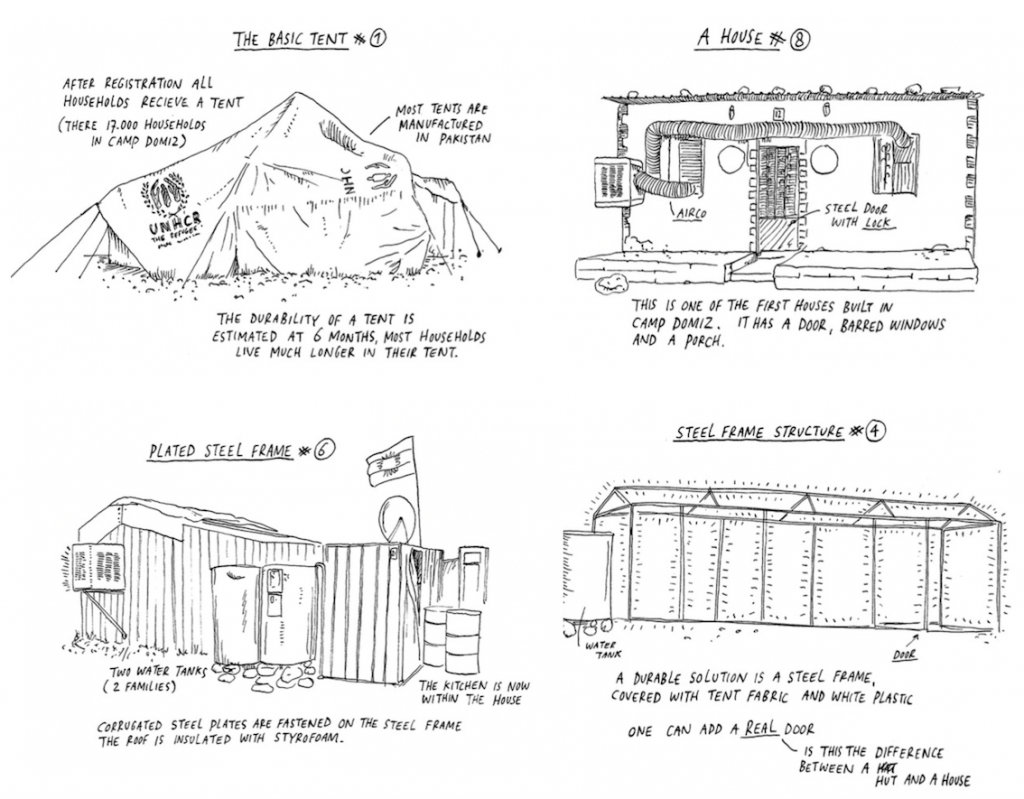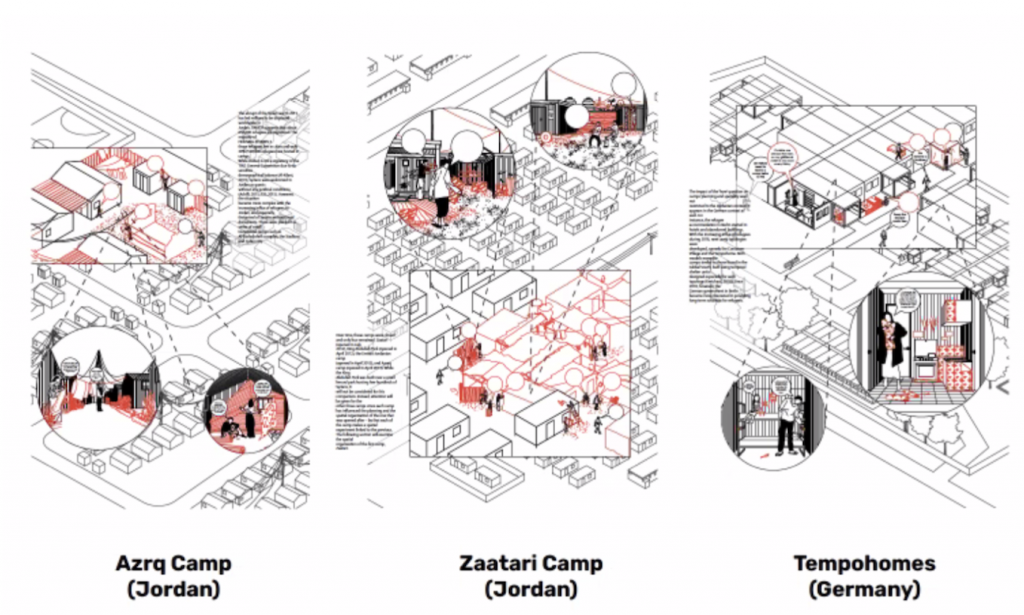Abstract Digital Spatial (Infra)structures: Shaping Possibilities of Migrant Movement Through Data Collection Methods, Audiovisual Surveillance, and Structural Mapping
Keywords – digital immigration methods ■ refugee ■ migrants ■ asylum ■ data collection ■ spatial surveillance ■ architectures of displacement ■ mapping technologies ■ Automated (Spatial) Learning Systems
Introduction: Abstract Digital Space as Reductive Space: Data Collection of Migrants
In the twenty-first century, a border is not just a line on a map; it is a system for filtering people that stretches from the edges of a territory into its heart. (Trilling, 2018: 10–11)
Immigration is an international procedure that enacts the enforcement of abstract invisible lines (i.e. borders) with regulatory mitigation methods placed upon an individual’s right to dwell. Thus, immigration is of an inherently abstract, spatial and architectural nature. Over the last two decades, immigration enforcement and border controls have gravitated towards shaping immigration outcomes through the employment of digital technologies, data-driven policies and surveillance practices. This shaping is done through digital methods of surveillance, monitoring and mass data accumulation of digital identities through social media monitoring (SMM) (Trottier, 2017), biometric data intakes, spatial mapping surveillance systems, and visual, photographic and/or textual data accumulation. Saskia Witteborn asserts that these digital methods currently employ legal consequences upon individuals as well as consequences imposed on how individuals live their identity on the ground. Witteborn thus argues that digital information is transformed into form and matter and, in turn, is transformed into potentiality, physical potentialities, potentialities of the physical world. In turn, abstract digital spaces shape physical (politicised) potentialities of human individuals. Thus, digital information taken from abstract (digital) spaces are given absolute (political and legal) power.
Typically, this digital data takes the visualized forms of data dots, data entries, and/or data clusters, which aim to calculate and read into human behaviour. At the same time, audiovisual and social media digital technologies are being employed as a source of connectivity, communication, emancipation, and agency for and by migrants and refugees seeking asylum. Akin to Leurs and Smets (2018), Witteborn examines the locativeness of agency in these digital methods in asking: Who has the power to see and interpret what this is?” (Witteborn, 2021) Witteborn declares the imperativeness of this question considering her informed belief that “digital abstract space will expand” (Witteborn, 2021) along with increasing complexity in digital identities in abstract space (e.g. digital media performances). Consequently, the climate in which digital methods are being deployed by immigration procedures is one where identification is replaced by identity.
Through referencing Witteborn’s conception of abstract digital space as a reductive space, which shapes future potentialities for migrant and/or refugee’s seeking asylum, I will examine three case studies concerning the spatial surveillance of refugees in sites and architectures of displacement. First, I shall begin with a case study concerning spatial surveillance through the PulseSatellite software. PulseSatellite is a software system that aims to classify patterns and count structures in refugee settlements through mapping architectures of displacement. Secondly, I will examine the interactive audiovisual website by the Dutch artist cooperative Submarine Channel called Refugee Republic. Refugee Republic is a website created through audiovisual recording of the narratives of dwelling refugees and structures of architectures of displacements that provide a “virtual” tour of a refugee site. Lastly, I will examine the 15-minute short architectural documentary entitled 13 Square Meters (2021). I will examine how the documentary uses audiovisual technology to record refugee narratives and architectures of displacement as a way to better the living conditions of displaced asylum seekers. Effectively, through these various new media case studies, I will ask the question: How do intangible, abstract digital surveillance methods contribute towards shaping tangible, lived-in potentialities for migrant and/or refugee’s seeking asylum?
Spatial Patterns of Inequality: Space, Mapping, and Artificial Intelligence Technologies
While trends of human behaviour are being extracted from digital data information, data is also a by-product of human behaviour. Consequently, there exists an inversely reciprocal relationship between human and non- human agents in data accumulation and extraction. Currently, many of the non-human systems which are included in this reciprocal relationship are Deep Learning and Automated (Spatial) Learning Systems. Today, most Automated Spatial Learning Systems are financed by commercial companies. In turn, as Witteborn explains, abstract digital spaces are highly institutionally driven and typically orientated towards calculation planning. Thus, abstract digital space is a calculated and market-driven space that consists of geometric and optical space, which can currently be seen through the creation of digital signs through the accumulation of abstract digital behaviour. In turn, these practices “driven by data processing and so called tech innovations”, “mean that migrants are bearing the burden of the new systems and losing agency in their migration experience.” (Privacy International, 2020)
Through digital data collection methods and space technologies, spatial patterns are now being mapped with the aim of calculating and sensing patterns of global inequality. One example of these market-driven abstract digital spaces with the primary aim of calculation planning is the software PulseSatellite. PulseSatellite is currently being deployed with the aim of “counting and classifying structures in a refugee settlement,” which Logar et. al term as camp mapping. (Logar et. al) Logar et. al explain that “for camp mapping, we have a Mask R-CNN model (He et al. 2017) trained on images from 12 settlements, where the image of each has been split into 300×300 pixel tiles and annotated by human experts. Once the model has been run on an unseen camp, the analyst can inspect the result in the tool and correct the outputs on a subset of tiles” (Logar et al.) (See Figure 1). Logar et. al argue that by using Computer Vision and Pattern Recognition (cs.CV); Human-Computer Interaction (cs.HC); Machine Learning (cs.LG); Image and Video Processing (eess.IV), “the potential use cases are numerous, such as monitoring population displacement, settlement mapping, damage assessment, flood assessment and identifying the direct impact of earthquakes, volcanoes, cyclones and landslides.” Morevoer, PulseSatellite software is currently running on Amazon Web Services (AWS), where “all backend files are generated and stored on [an] Amazon Elastic File System (EFS).” (Logar et al.)

Figure 1. “PulseSatellite mapping a refugee camp in Jordan. Model detected building are highlighted in blue, with analyst evaluation structures in green.”
Consequently, these spatial mapping technologies, financed by Amazon and stored on their backend files, are monitoring refugee settlements and behaviours without their consent. Thus, as Privacy International points out, there are three main take-a-ways concerning the current datafication methods deployed on migrants and/or refugees seeking asylum: 1) “Migrants are bearing the burden of the new systems and losing agency in their migration experience, particularly when their fate is being put in the hands of systems driven by data processing and so called tech innovations.” 2) “Large amounts of data are being requested from migrants, from their fingerprints to their digital data trails, while they are often put in a situation of constant surveillance.” 3) “Private military and security companies play essential roles in providing a variety of surveillance tech and data exploitation ‘solutions’ and services to governments.” (Privacy International, 2020)
Interactive ‘Surveillance’ of Mapped Refugee Spaces: Refugee Republic by Submarine Channel
With that being said, the award-winning interactive audiovisual website Refugee Republic uses online, digital audiovisual technologies in order to enhance visibility (Trottier, 2017) by providing an “virtual” tour of a refugee camp. Specifically, the refugee settlement called Domiz Camp (Duhok, Iraq), which was founded in 2012 and primarily consist of individuals and families from the Kurdish area in Syria. The Refugee Republic project was created by Dutch designers Submarine Channel and was funded by Creative Industries Fund NL, Media Fonds, NL Film Funds, One World, Free Press Unlimited, and Gementee Amsterdam.“On the Refugee Republic website you can explore the camp through the pen drawings of an artist, the lens of a photographer and the ears of a radio producer. You meet the residents and get to know them by scrolling through audio- visual narratives, or wandering through drawings enriched with sound.” (Submarine Channel)

Figure 2. Birds-eye view of Domiz Camp map on homepage of Refugee Republic website.
The journey into the website begins by providing a a birds-eye view map of the entire Domiz Camp (See Figure 2). When hovering over this map, several routes are demarcated by different colours and rise up along with highlighted story lines. These routes include: Camp Smart (green), Camp Construction (teal blue), Camp Money (orange), Camp Life (yellow). At the bottom of the screen runs a continuous ‘news ticker’ stream of camp facts such as: “Domiz Refugee Camp was established in April 2012 to host Syrian Kurds. / The camp is located 20kms southeast of Dohuk city, in Iraqi Kurdistan and 60km from Syria-Iraq border. / The size of Domiz Camp is 1, 142, 500 m2. / There are 12 Quarters, 10 main streets and 99 side streets. / The average income for labourers is $275 per month. / 81% of the income is used for food. / Since November 2014, 3,027,317 Syrians have been registered as refugees. Another 177,939 are waiting to be registered. / 45% of the population are female. / 55% of the population are male. / 37% of the population are below the age of 15. / 57% of the population are aged between 15 and 49, only 38% of this group are female. / The average age is 21. / The camp needs 4.5 megawatts of electricity per day. / The camp uses 2200 m3 of water per day, which is distributed by trucks and regular infrastructure. / Four families share one latrine and one shower. / An average of 324 people per day make use of the primary healthcare. / There are two hospitals in the camp. / There are 7 schools in the camp” (Republic of Refugee) and so on.
After choosing a coloured Camp route, one is able to enter a first-person, Google Street like view of Domiz Camp. With a soundtrack emitting “natural” noises from the environment (sounds of cars driving, cars honking, birds chirping, children chattering, footsteps, etc.) and local music playing, one is able to enter a two-dimensional virtual world and wander through the sketched infrastructure and photographed architecture(s) of Domiz Camp. Throughout the sketched journey, one will stumble across drawings of satellites attached to oil barrels and written quotes such as “When does a structure become a house?” Eventually, the user finds their way into the various narrative story lines associated to each unique coloured Camp route. These story lines are shown by moving and/or still photographic images, audio, and/or written translated text and depict site structures such as the camp’s homes, mosques, ‘stores,’ and schools. One story highlight in Camp Construction, entitled “From tent to house”, provides sketches of the various types of refugee’s architectures of displacement: 1) The Basic Tent, 2) The Improved Tent, 3) Shelter with Wooden Frame, 4) Steel Frame Structure, 5) Extended Steel Frame Structure, 6) Plated Steel Frame, 7) Sustainable Structures, and 8) A House (See Figure Series 3). Through visualising the structures of the architectures of displacement, one is able to see the way in which there is very tangible and physical way that displaced refugee’s have to mitigate between agency and structure (Awad, 2021).

Figure 3. Architectures of Displacement on Refugee Republic website.
Spatial Experiments in Architectures of Displacement: 13 Square Meters
Compassionate probings into the structural design of refugee homes and shelters as well as refugee narratives was directly tackled by the makers of the architectural documentary 13 Square Meters (2021). 13 Square Meters (2021) is a 15-minute short film created by Kamil Bembnista & Ayham Dalal produced for the research project A04 “Architectures of Asylum.” The project was funded by the Collaborative Research Center for the “Re-Figuration of Spaces” in a joint effort to investigate how “people are renegotiating, changing, and adjusting the relationship to their spaces, as well as the social, political, and technological consequences of this – and how this process can be controlled.” (Klaaßen, 2018) Specifically, this investigation of space took place at a new type of refugee camp in Berlin referred to as “Tempohomes” (See Figure 4). Tempohomes build prefabricated modular systems such as steel frame shipping containers (See Figure 5).

Figure 4. Dalal, Ayham. Map of Tempohomes.

Figure 5. Tempohomes at Berlin refugee site. 13 Square Meters (Screenshot).
The documentary directly addresses “ideas of displacement, space and architecture, while opening up a discussion on the similarities and differences between refugees’ shelter design and the production of modernist mass housing in cities.” (Bembnista & Dalal) By recording narratives of the dwelling refugees and their homes, Ayham Dalal was able to reconstruct the architectural structures of the refugee’s living spaces as well as reconstruct the guidelines and limitations imposed on regulating interior design and cultural appropriation of the space. Consequently, 13 Square Meters deconstructs mapping transformations of space, how identity and culture are created through the structural building of space, and notions concerning the right to dwell and appropriate personal space.
Moreover, as described by Bembnista & Dalal, 13 Square Meters,
highlights the links between refugee shelters, the city’s everyday architecture and the production of mass housing. By juxtaposing the initial design of shelters with refugees’ rearrangements of space, the documentary questions the role of architecture: how can we offer displaced populations better conditions to dwell? Can shelters be spaces of “care” without “control”? How can architecture empower people to express their culture, background and identities – in camps and beyond? How did refugees within these camps navigate meanings of “home”, and how did the camp managers respond to refugees’ appropriations?
In this context, the monitoring and recording of refugee space, while problematic in some cases due to individual’s privacy, allowed helpful insight into how people use their personal knowledge of space. In turn, these insights proved useful in providing tangible adjustments to the architectures of displacement as well as adjustments towards the intangible guidelines regulating the material appropriation of dwelling space. Moreover the recording and public sharing of the 15-minute audiovisual documentary, which also showcases the architectural process, allows outsiders to gain insight into the struggles faced by refugee’s live-in experience(s).
Conclusion
While the topic of immigration is already one which concerns the enforcement of intangible and invisible lines placed on an individual’s right to dwell, digital immigration methods and spatial surveillance systems have infeasibly fed into the level of power these non-physical lines have in the tangible world. Thus, intangible, abstract digital surveillance methods significantly contribute towards shaping tangible, lived-in potentialities for migrants and/or refugee’s seeking asylum. Whether through digital immigration methods and/or spatial surveillance technologies imposed on migrants. Or, whether through the interactive audiovisual technologies recording refugee sites in order to contribute positive change by altering tangible architectures of displacement. Consequently, these intangible digital methods and spatial surveillance systems are increasingly shaping tangible potentialities for migrants and/or refugees seeking asylum. Thus, intangible (spatial) data of migrants and/or refugee’s extracted from abstract (digital) spaces are, in turn, given absolute tangible power.
Works Cited
Awad, Isabel. (2021). What about the actors involved in news about poverty? Disrupting determinist accounts. In. S. Borden (Ed.). The Routledge companion to news media and poverty (pp. 192-201). Routledge.
Bembnista, Kamil, and Dalal, Ayham. (2021) 13 Square Meters – Documentary (15min.). Retrieved from: https://sfb1265.de/en/news/13-square-meters/
Engelbert, Jiska, Awad, Isabel & van Sterkenberg, Jacco. “Everyday practices and the (un)making of ‘Fortress Europe’: Introduction.” European Journal of Cultural Studies 1-11: Volume 22, Issue 2. 133-143. 2019. https://doi.org/10.1177/1367549418823055
European Commission. “Sensing Global Patterns of Inequalities From Space.” Science For Policy Briefs. Brief based on the JRC Technical Report: JRC113941, Daniele Ehrlich et al., JRC Working Papers, 2018. DOI: https://dx.doi.org/1 0.2760/642218. Retrieved from: https://ec.europa.eu/jrc/sites/default/files/ fairness_pb2019_inequality_remote_sensing.pdf
Gillespie, M, Ampofo, L, Cheesman, M, Faith, B, Iliadou, E, Issa, A, et al. (2016) Mapping Refugee Media Journeys: Smartphones and Social Media Networks. Research Report. Paris: France Médias Monde and The Open University.
Klaaßen, Lars. (2018) “More Than Three Dimensions.” Berlin University Alliance. Retrieved from: https:// www.berlin-university-alliance.de/en/impressions/20180524-crc-refiguration-of-spaces/index.html
Leurs, Koen, and Kevin Smets. (2018) “Five Questions for Digital Migration Studies: Learning From Digital Connectivity and Forced Migration In(to) Europe.” Social Media + Society. DOI:10.1177/2056305118764425.
Logar, T., J. Bullock, E. Nemni, L. Bromley, J. A. Quinn, and M. Luengo-Oroz. (2020).“PulseSatellite: A Tool Using Human-AI Feedback Loops for Satellite Image Analysis in Humanitarian Contexts”. Proceedings of the AAAI Conference on Artificial Intelligence, 34(9): 13628-9. DOI:10.1609/aaai.v34i09.7101.
Migration Data Portal. (2017) PulseSatellite: A collaborative tool using human-AI interaction to extract information from satellite imagery for humanitarian purposes. Retrieved from: https:// migrationdataportal.org/data-innovation/PulseSatellite-human-AI-information%20-satellite-imagery- humanitarian
Privacy International. (2020) 10 Threats to Migrants and Refugees. Retrieved from: https:// privacyinternational.org/long-read/4000/10-threats-migrants-and-refugees
Submarine Channel. Refugee Republic. Retrieved from: https://refugeerepublic.submarinechannel.com/ Submarine Channel. Refugee Republic: Presskit. Retrieved from: https://
refugeerepublic.submarinechannel.com/press/Refuge_Republic_Presskit.pdf
Trilling D (2018) Light in the Distance: Exile and Refuge at the Borders of Europe. London: Picador.
Trottier, Daniel. (2017). ‘Fear of contact’: Police surveillance through social networks. European Journal of Cultural and Political Sociology, 4(4): 457–477. DOI:10.1080/23254823.2017.1333442
Witteborn, Saskia. (2015) “Becoming (Im)Perceptible: Forced Migrants and Virtual Practice.” Journal of Refugee Studies. Published by Oxford University Press. DOI:10.1093/jrs/feu036
Witteborn, Saskia. (2019) “The Digital Gift and Aspirational Mobility.” International Journal of Cultural Studies, 22(6): 754–769. DOI:10.1177/1367877919831020.
Witteborn, Saskia. (2011) “Constructing the Forced Migrant and the Politics of Space and Place-making.” Journal of Communication, 61(6): 1142 – 1160. DOI: 10.1111/j.1460-2466.2011.01578.x